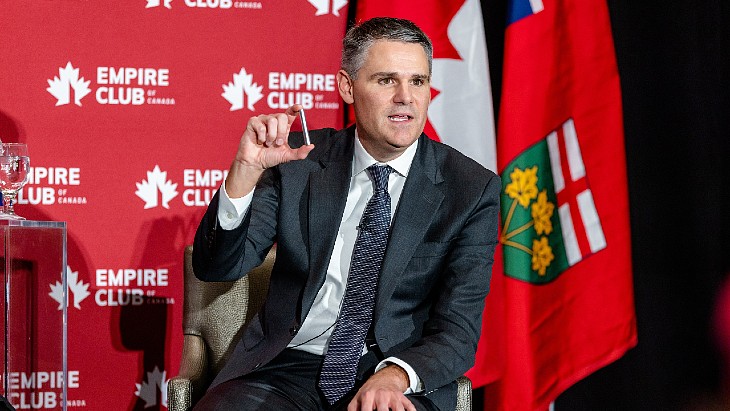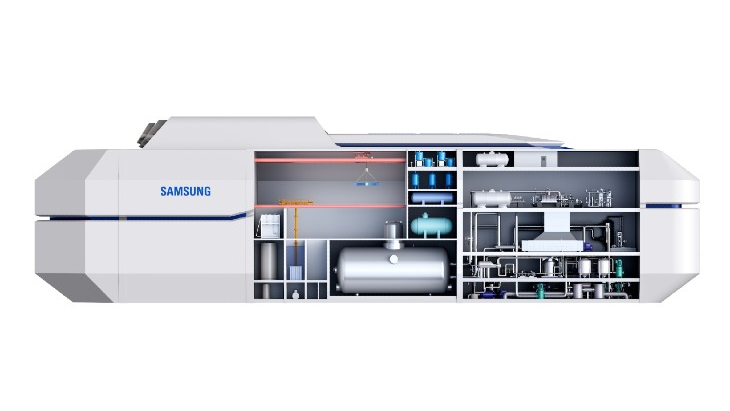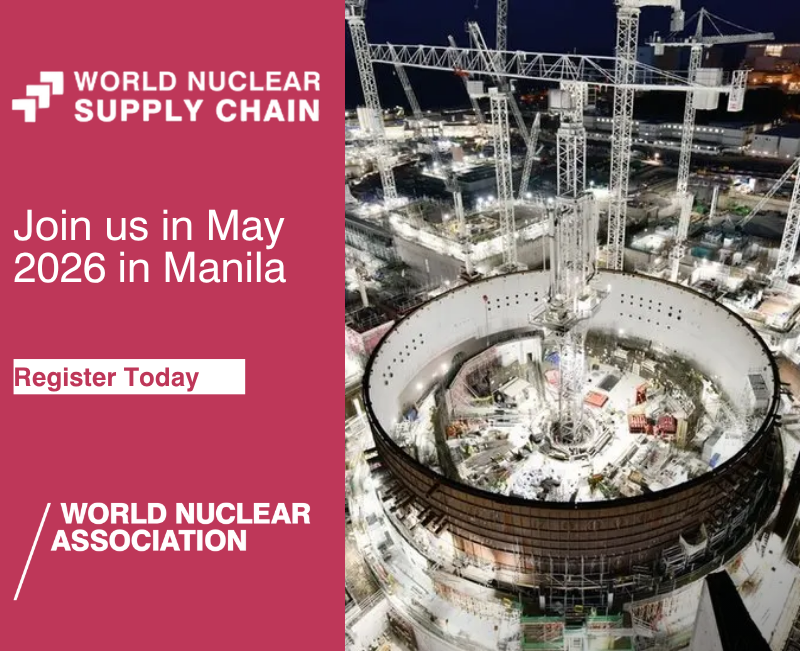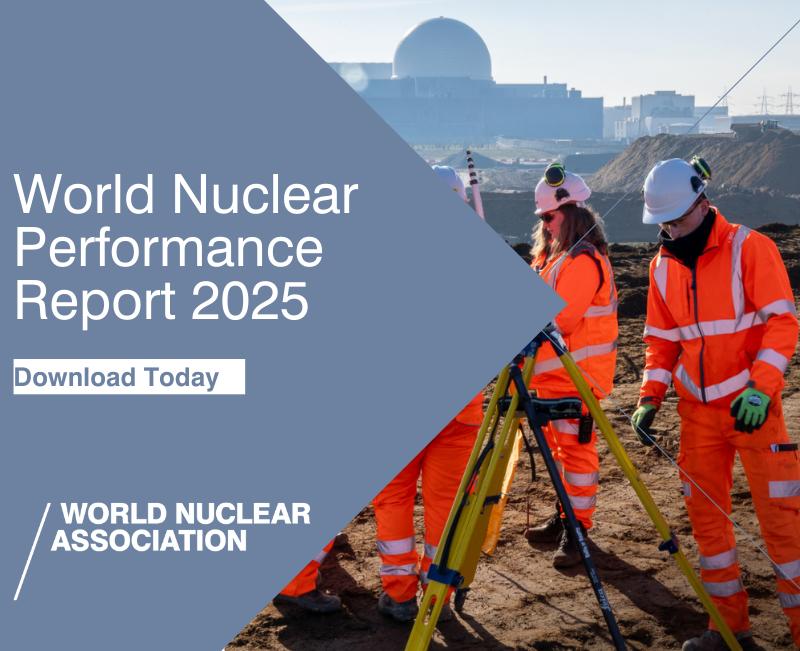What is the Canadian Nuclear Isotope Council?
We have a very proud history of medical isotope development in Canada and have been a world leader for more than half a century. So the Canadian Nuclear Isotope Council was born out of the need for Canada's isotope sector to come together. In 2018 a group of us came together to recognise that it was really important for us to unite as a cross-functional sector to talk about what the next 50 years could look like. We have more than 100 members and the goal is to ensure that Canada continues to play a leadership role, with a key element being to double Canada's production of life-saving medical isotopes by 2030.
Do you have a favoured way explaining what isotopes and radioisotopes are?
The way I always look at it is that an isotope is really just another form of energy. So what we're commonly known for in nuclear is that we produce large volumes of steam energy and convert it into electrical energy. In the case of medical isotopes, it's really just another form of energy. And what we're doing, and we're talking about reactor-based isotopes whether it's in a research reactor or a Candu power reactor, is taking advantage of the large volume of neutrons that we have and using that to produce medical isotopes. We have some that are long-lived medical isotopes, such as cobalt-60 with a very long half-life so they tend to be used in applications that are consistent with that duration, things like sterilisation, things like certain types of medical devices that are more permanent that treat something, like the gamma knife or the GammaPod for brain tumours or breast cancer. But then we also have short-lived medical isotopes like the ones that we produce at Bruce Power - lutetium-177 or molybdium-99 - that is produced at Ontario Power Generation, and these are short-lived medical isotopes, and it makes sense that a lot of our diagnostics and therapeutics use those short-lived medical isotopes because we only want to use them for a short period of time on a patient for its intended purposes.
So I just look at it as another form of energy, but I do believe that it is a form of energy that we do not talk about enough. We would not have the global healthcare system we have today without isotopes from power reactors and research reactors. We would not have literally billions and billions of pieces of personal protective equipment and single-use medical devices clean and ready for hospitals and medical settings to use. If it wasn't for our reactors, we wouldn't have the ability to diagnose cancer in many cases and we wouldn't have the ability to treat it. I think this is an area that is really not understood and I think it's a very strategic asset to what the global nuclear industry can provide society.
Listen to the full interview:
And different isotopes are used for different purposes?
Yes, that's right. On our website we have a really good overview of a patient and talk about different types of cancer, whether it's in diagnostics or therapeutics, in terms of what medical isotope is used for what application. In a broad sense medical isotopes are used in very high volumes in diagnostics, so molybdium-99 is used at hospitals around the world to be able to diagnose cancer and and understand where cancer may be challenging a patient in terms of where it is in the human body. Then we have other isotopes which are used for therapeutics, whether that is an iodine that is used on a certain targeted area of a patient, whether it is for a form of a brain tumour and cobalt-60 is used where you use a beam therapy. So isotopes, based on both their their lifespan, their rate of decay but also their their attributes, allow them to be targeted for various types of cancer. What you are seeing start to evolve in radiopharmaceuticals are isotopes which now we call theranostics - just by the word you can you can tell that it's a combination of the words diagnostics and therapy. And these are the isotopes that are really emerging in prominence all over the world. An example of that kind of isotope is lutetium-177. There's more than 200 clinical trials and studies and developments under way with lutetium, but in particular with prostate cancer or certain types of neuroendocrine tumours where lutetium can find the cancerous cells without impacting the healthy cells around it and also to treat it. There's also non-reactor-based theranostic-type isotopes like actinium-225. So yes, different isotopes have different uses and if you look at the membership of the Canadian Nuclear Isotope Council, we have a lot of leading, not only pharmaceutical companies, but post-secondary institutions, along with a lot of large healthcare institutions that provide this kind of treatment led by oncologists. So it's really about finding the right isotope for the right use. However, what we're starting to find is that these theranostic isotopes are used for a very broad spectrum of potential treatments.
What do you think has been driving the rapid growth in demand?
I don't think the growth has been surprising and I think we're going to see exponential growth in the future. One of the things that is an unfortunate reality is that 40% of us in our lives will get cancer, and 100% of us will be impacted by cancer. It doesn't matter what country in the world you live in. It doesn't matter what jurisdiction you're a part of - those statistics are pretty common around the world. Any of us who has known somebody who has been challenged with a cancer diagnosis know that there continues to be a better and a broader range of treatment options for cancer patients. And that's a great thing, combined with early detection. So as we've developed better medical treatments around the world to diagnose and treat cancer, that in itself has led to a growth in demand for medical isotopes. That's probably the most obvious driver of the growth. But more importantly, and we recently signed an agreement with the International Atomic Energy Agency (IAEA) to support their Rays for Hope campaign, if I look at it from a global perspective, there are hundreds and hundreds of millions of people in the world today that do not have access to the cancer treatment that we first had in Canada 73 years ago, whether that's in areas of continental Africa, whether it's in other poorer regions of the world. We all want a world where more people continue to strengthen their level of prosperity. And typically, as communities and economies and countries enhance their prosperity, so too will their access to what in Canada is a very basic part of healthcare. So as more of the world population has access to these treatments, and we're talking very large portions of the world population that doesn't have access to them, they will need those basic components that we rely on in developed countries, whether it is supply, whether it is distribution, whether it is administration of medical isotopes. And that's where I think the Director General of the IAEA has shown extraordinary leadership in recognising that as a global nuclear industry and global isotope consortium we need to come together to do whatever we reasonably can to ensure that many of these countries and communities have access to cancer treatments and diagnostics that we have become very accustomed to.
What share does Canada have of the global sector, and how might that change?
Well, it really depends on the type of isotope, but if you look at isotopes such as cobalt-60 Canada is the the world's largest supplier. Cobalt-60 is produced primarily from the Bruce Power reactors and at the Pickering Nuclear Generating Station east of Toronto by Ontario Power Power Generation, so Canada would be the dominant provider of cobalt-60 and a lot of that is through our partners at Nordion who export that all over the world. If you look at supply such as iodine-131, very heavily produced at McMaster University's research reactor, again exported all over the world. If you look at the work that Ontario Power Generation and BWXT Medical are doing in molybdenum-99, again, we have very dominant source, or in the case of Bruce Power, lutetium-177 will be one of the world's largest suppliers. So Canada is a very dominant supplier. And part of the reason for that is we have an infrastructure in Canada that is quite unique to other jurisdictions in the world. We have a fleet of cyclotrons that are used for non-reactor based isotopes. We have research reactors in the case of McMaster University in Hamilton, Ontario, and then we have a large Candu reactor fleet in the province of Ontario and New Brunswick and and the Candu reactor has a unique ability to produce isotopes that other reactor designs don't, and that's really because of its ability to access the neutron source in the reactor core, because in a Candu reactor, instead of one large pressure vessel, a Candu reactor really has 480 separate pressure vessels, and it's because of the the nature of the design and the the nature of the the flux in the reactor that that provides that. So by its very nature Canada is a dominant player in this space. But what I would also say is that this is a space where we can all work together. It's a space where the world needs as much redundancy and supply as it can get. So what I would say is that we very much take a collaborative approach to this and we, as Canadians, look at this as the world really counting on us to play our part because of those unique capabilities that we have.
What about other countries with Candu reactors?
Some other countries - such as China, South Korea and Romania - that have Candu reactors are looking at it and you also see a number of jurisdictions who have other reactor technologies looking to see how those can be leveraged for isotopes as well. I think it's very important that we as a nuclear industry provide, as we do when it comes to electricity supply, reliability and redundancy. That's really our value proposition and we all know that we live and breathe it every day in our base operations. And I think as we reflect on the role we'll play in isotopes, it's the same role we want to play. If the world is going to count on us for medical isotopes like they do today, we need to make sure we have the reliability and the redundancy. When somebody turns their light switch on at home they expect that power to come on. When an oncologist is ready to give a patient cancer treatment, we need to make sure they have the isotopes that they need to provide that patient with the best chance of success at what is a very challenging time in their life.
How does the isotope business fit in with the core business for Bruce Power. Is it effectively a 'side hustle'?
I think it would be a mistake to look at this issue and the opportunity around medical isotopes in terms of what portion of your revenue it is. Anybody who operates a nuclear plant understands the volume of electricity that is being produced and the revenue associated with that. So if you compared revenue for medical isotopes to revenues for electricity, it might sort of look like a side hustle. But what I always say is that it may be 1% of our cash flow, but it is 50% of our contribution. What I mean by that is that if we want to be successful as an industry, as a nuclear industry, we need to look to what are some of the greatest challenges that communities and society are facing and how we can contribute to those. And that goes beyond just the pure day-to-day elements of producing electricity. Clearly we have no future unless we do that safely and reliably every day, we know that. But for the industry to grow and be robust and also be resilient through changing political times, we need to look at what contributions we can make to to broader society. Often-times as an industry, we talk about our contribution to fighting climate change. I don't think we talk enough about our contribution to energy security and how important that is from a geopolitical perspective. But also, when we look at just the impact that every person who lives in the world is going to be impacted by cancer in their lives one way or another. My point is that if we, as an industry, in addition to fighting climate change, providing energy security, creating good jobs and facilitating economic growth - if we can be leaders in the global fight against cancer, how incredible of an opportunity is that for our industry? So I think it is core. I think it is absolutely essential and I think as an industry we need to continue to challenge ourselves to think outside of the box. What are the other challenges humanity is going to have and how can we meet that challenge? That is what is going to allow us to be resilient and robust. And I think it's really important in terms of the long-term acceptance of nuclear power. We are a very misunderstood industry and often-times we think that being able to pull out a calculation and an analysis of something is going to be the way to make our case. No, the way to make our case as an industry is to continue to positively impact people's lives. And so I see it as very core to what we do. It is right in Bruce Power's mission statement. I can tell you, if you went and talked to any employee at Bruce Power and asked what is your job, they would say they do two things - generate safe, reliable, clean electricity, and produce life-saving medical isotopes.
Talking of Bruce Power, how are things going?
It's a very exciting time at Bruce Power. Of our eight reactors we have three of them fully refurbished. We have two refurbishments under way right now with plans to complete the balance of the fleet here by the early 2030s. Our life extension refurbishment plan has been safely executed with quality, on schedule and on budget, and that's the predictability we want. But not only have we been able to continue to advance that project, what we've also been doing is ensuring we reliably produce electricity from our operating units, which the people of Ontario and Canada are relying on, while we've also been progressing a project called Project 2030 which is that as we continue to life-extend the units we also increase the output of the units. So more supply from existing units and our goal is to continue to maximise the output from our units. We fundamentally believe that the more clean nuclear power we produce, the better in terms of keeping electricity costs low for rate-payers on the one hand, but on the other hand reducing the need for fossil fuels. We recently achieved a very exciting milestone in reactor 4 where we completed what we call the defuel of the unit in record time. So things are going well but we never take anything for granted, we are only as good as our last day of performance. So we are really focused on that. In terms of increased capacity, when we started Project 2030 back in 2018 site peak assumed all the units running at peak of about 6300 megawatts. Our goal through Project 2030 is for the 2030s and a new site peak of around 7000 megawatts, so up to an additional 700 megawatts at peak. Clearly new reactors are going to be needed to meet growing demand, but as a nuclear industry, we need to always remind ourselves that speed is sometimes a challenge in our industry with getting new nuclear online and so not lose sight of the role that our existing assets can play both in terms of additional output from those units but also continuing to work with the World Association of Nuclear Operators and through our various peer groups on what can we do to continue to improve and enhance the equipment reliability and lifetime of our units. In terms of new units, we are also advancing with an impact assessment for Bruce C - that's our environmental permitting process for a new nuclear plant. We are about a year and a half into that permitting process. It is advancing well and our goal is to complete that permitting process within a couple of years. That permitting process will allow us the opportunity as we are ramping down our refurbishment programme, to look at what our new build options are. We thought it was prudent to advance that permitting process in parallel.
How do you see the general outlook for nuclear energy?
I think that it's very clearly a time of significant momentum for our industry. What I would say is that it is all going to come down to our ability to execute against the opportunity. And if I take a step back and I think about what has made us successful in our refurbishment programme at Bruce Power, there's been a number of ingredients to that that I think are lessons we can all learn from and build on for other nuclear projects, and the same would go, I think for our our friends at Ontario Power Generation who we've worked very closely with. The first is a stable policy environment where nuclear operators, people looking to build new nuclear have an appropriate policy and regulatory environment, that's a key building block. I think regulatory certainty with our independent regulators across the world, knowing in a fact-based way what the expectations of your regulator are is really important. And then with that, whatever you're going to refurbish, whatever you're going to design, whatever you're going to do, that it is being done in a way that it's been designed, it's been completed. Don't put a shovel in the ground until something is fully designed has been our mantra and that has served us well from a price predictability point of view. And then you're able to procure components against that and scale a workforce against that, so I'm a big believer that sometimes you need to go slow to go fast. think that as an industry we need to look back at the times we've been successful with large-scale nuclear. And I think the Candu refurbishments are one proof point of that. Look at where we've had challenges and make sure we learn from those lessons because I believe if we can apply those lessons, I think the world will probably take as much nuclear as we can actually transact. I don't think this is going to be an issue of 'do they need the amount and do they need nuclear?' I think it's going to be 'can we deliver it'? I think if we can deliver it, I think it creates that sort of circular environment where that support will be there to keep going. But what we can't afford as an industry is any concerns around the performance, safety or otherwise of the units. Every single day we have to earn that public confidence which I think we've rebuilt since the Fukushima event in 2011. We can't have an industry-wide event and we can't allow costs to overrun in one project in one part of the world providing a poor economic outcome that impacts the view of nuclear everywhere. We are part of a global community and we all need to be successful together, both in our base operation but also in the execution of our project work.
Switching back to isotopes, how does it feel to see some of the emerging clinical trial results?
My family, like probably your family, has been impacted by cancer. So I think it is important to express optimism and hope, but also be realistic as well. Medical isotopes are doing amazing work for many patients but I think we still need to recognise that whether it is through isotopes or other pharmaceutical-type treatments, there are still a lot of forms of cancer that we don't have the right silver bullet for. So that's something we need to all keep in mind. And I think it keeps us motivated to keep researching and developing. The way I look at it, and I think broadly the Canadian Nuclear Isotope Council has always looked at it is, if I compare it to the the energy debate where we talk about forms of energy, you know the word that people often use is 'all the tools in the toolbox'. I would apply the same principle to cancer diagnostics and treatment. What we want to provide our frontline healthcare professionals is a range of tools to detect and treat cancer. We know that cancer is something that is very unique to individuals, very unique to certain types of cancer so I'm very much a big believer in that diversity of tools in the toolbox. I think radiopharmaceuticals are an evolving and growing and very important tool in the toolbox. But we need to continue to be going after everything that we can on this front and the research and development that is under way around the world on this is quite impressive. Just in the case of lutetium-177, which is the the new short-lived isotope we're producing at Bruce Power, there's over 200 either studies use cases, clinical trials under way to use that isotope right now. It's used in prostate cancer and in certain types of tumours as I mentioned earlier. And there's new applications looking at it, for example for lung cancer. So we need to continue to expand the the research and development on this because we still don't have a silver bullet for any of these types of cancer yet.
Looking at the 100+ members, it really is a sizeable industry
Yes, it's a full industry. It's across the entire country of Canada, coast to coast to coast. It covers everything from research institutions, to production, to use. It's not just a nuclear power play. The commercial nuclear plants are a part of it but we are not the only part of it and and we really like to refer to it as an integrated ecosystem, an integrated supply chain, an integrated knowledge base for the future of developing new treatments and to continue to give patients as much hope as we can, we need that ecosystem all working together. We are always stronger when we come together and we work together with a sense of urgency and a sense of purpose.
And finally, a word about the Isotopes for Hope podcast you host
Often-times in nuclear we are really good at doing the work, but sometimes we're not as effective at communicating it and sharing it. On Isotopes for Hope we feature leaders from across Canada and across the world in this space - this is a real hidden gem of what our industry around the world does and it's very important that we get this important message out. (You can find the podcast on Spotify, Apple and all other good podcast platforms).






_18570.jpg)
_16159.jpg)
_49205.jpg)



